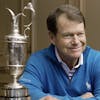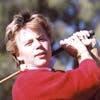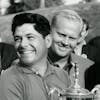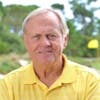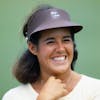Murle Breer - Part 1 (The Early Years)
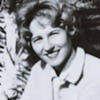
In this captivating first of a two-part episode of "FORE the Good of the Game," join hosts Mike Gonzalez and Bruce Devlin as they dive into the inspiring early years and professional career of major champion Murle Breer.
A five-time professional winner with four LPGA Tour victories, Murle's stories take listeners on a vivid journey back in time to the early days of her career. From her major win straight out of the box to the mentorship she received from the iconic Patty Berg, this episode offers a rich tapestry of golf history.
But it's not all fairways and greens; Murle's tales go beyond the course. Hear her recount a thrilling and terrifying night camping with Wiffie Smith in Gatlinburg, Tennessee, where encounters with black bears put her golfing challenges into perspective. "What's a three-foot putt after that, right?" she quips.
Listeners will be intrigued by Breer's insights into the clinics by Patty Berg, where the mantra "ball first, turf after" became a staple lesson. These weekly clinics, where players would be lined up and asked to hit different shots, provided a crucible for Murle's growth as a golfer. The camaraderie and support from legends like Marilyn Smith further underscore the spirit of those times.
The episode doesn't shy away from the challenges, either. Murle's candid recounting of her first clinic in Havana, Cuba, where her awkward stance was corrected by Marilyn Smith, adds depth and character to her journey.
This episode is sure to resonate with listeners interested in the history and timeless aspects of golf. Whether you're a seasoned golfer or new to the game, Murle Breer's life story, told in her voice, brings a bygone era of golf back to life and celebrates the influences that shaped her remarkable career.
Don't miss this engaging episode – it's a slice of golf history that's sure to inspire and entertain as Murle Breer begins her life story, "FORE the Good of the Game."
Follow our show and/or leave a review/rating on:
Our Website https://www.forethegoodofthegame.com/reviews/new/
Apple Podcasts https://podcasts.apple.com/us/podcast/fore-the-good-of-the-game/id1562581853
Spotify Podcasts https://open.spotify.com/show/0XSuVGjwQg6bm78COkIhZO?si=b4c9d47ea8b24b2d
Google Podcasts https://podcasts.google.com/feed/aHR0cHM6Ly9mZWVkcy5idXp6c3Byb3V0LmNvbS8xNzM3Mjc1LnJzcw
About
"FORE the Good of the Game” is a golf podcast featuring interviews with World Golf Hall of Fame members, winners of major championships and other people of influence in and around the game of golf. Highlighting the positive aspects of the game, we aim to create and provide an engaging and timeless repository of content that listeners can enjoy now and forever. Co-hosted by PGA Tour star Bruce Devlin, our podcast focuses on telling their life stories, in their voices. Join Bruce and Mike Gonzalez “FORE the Good of the Game.”
Thanks so much for listening!
Welcome to another edition of FORE the Good of the Game and Bruce Devlin, we've got a guest this morning that's much younger than you. She's a major champion. And she's just right down the road from me.
Devlin, Bruce:That's right. She is here. She says she's about 18 months younger than me. She looks a lot younger than that, though. I must say. This young lady has won four times on the LPGA Tour that is and in 1962 was the U.S. Women's Open champion. What a pleasure to have with us today Murle Breer. Thank you Murle for joining and I. We look forward to this. Thank you.
Breer, Murle:I look forward to it. Also,
Mike Gonzalez:Murle, great to have you welcome to for the good of the game. And as we've talked about, we're here to tell your life story. And to do that we have to start at the very beginning. So why don't you tell us about what life was like growing up, I assume in Florida?
Breer, Murle:Yes. I grew up in St. Petersburg, Florida. And we we were just an average family never played golf in my life. And I went to a movie called Pat& Mike. Spencer Tracy and Katharine Hepburn. Yeah. And I just was watching that movie. And I came home and I said, I want to be a professional golfer. My brother played baseball, and I thought there's there aren't any opportunities for for women in any sports except golf or tennis. So I thought I'm gonna take off. And not long after that. There was an A in the paper about a clinic for youngsters. So my mother took me to that. And I played a lot of softball and was into a lot of sports. And I thought I could play golf. I thought it was gonna be easy. But everybody knows how hard and difficult golf is. Always remember being at the clinic and the golf pro was explaining the grip. And I thought I can grip it the way I hit a baseball better. And I was out there hitting balls and the balls would never get up and they wouldn't get airborne. So he came over and fix my hands on The Club. And I swung and the ball went up in the air and it just thrilled me so much. I thought you know what you're talking about. Anyway, that was that was the beginning of my golf. Going.
Mike Gonzalez:How old were you when you saw that movie?
Breer, Murle:I was about 14.
Mike Gonzalez:All right, and just remind our listeners who some of the LPGA stars were that were featured in that movie. Do you remember?
Breer, Murle:I think Babe Zaharias. Probably Patty Berg, and I think Marlene Hagge was in and I'm not sure. But I remember Babe Zaharias.
Mike Gonzalez:Well, she might have been and as you as you remind us of Marlene Hagge Of course, we should note to our listeners. We're recording this in the year 2023. And unfortunately the last living founder the LPGA Tour, Marlene Bauer Hagge passed away just recently, so we will certainly talk about her and the other Founders, but I'm sure that's a lady you remember well.
Breer, Murle:Oh, I do. Marlene was a great player. She worked hard. And she she was always set. A good example, I think on the Golf Course for all of us. She was very feminine. And I was kind of a tomboy a little bit when I was younger. And when I came out on tour, I think Marlene kind of helped me to know how to dress. He was very helpful. And so I I have good memories of Marlene.
Devlin, Bruce:Well, I have a long memory of her Murle that you might be interested in. When I was 17 years old. I played in a golf tournament in Australia called the Lakes Open. And Marlene Hagge was there and I in the pairings for that golf tournament. On the Thursday I was paired with Kel Nagle whose name you will remember. And Marlene Hagge and I walked in had lunch had lunch with the both of them and she said to me, she said to Kel first of all, she said Kel is this your son. Kel said, No, this is not my son. How old do you think I am? He's 17. How old do you think I am? She said, Oh, no. He said, Well, I'm 34. She said, well, well, that would work. So it was sort of funny.
Breer, Murle:Marlene, at that time.
Devlin, Bruce:That's right. Yeah. Well, she couldn't have she, I think she was a little bit older than me. Maybe maybe 20. So that would put her passing at like 89. Would that be about right, I think?
Breer, Murle:I think so. Thanks.
Mike Gonzalez:And sort of interesting history there, too, which you may be aware of Merle, as you as you probably know, her and her sister Alice were two of the 13 founders of the LPGA Tour. Alice married to a guy named Bob Hagge. They then ended that marriage and Bob goes on to marry Marlene Hagge, the sister. Bob then later changes his name to Robert Von Hagge. And guess who Bruce Devlin partners up with for 130+ Golf Course designs around the world. Robert Von Hagge.
Breer, Murle:Small World is an amazing story.
Mike Gonzalez:Yeah, yeah. So let's get back to your younger childhood. And then we're going to talk some more about LPG history. But so you see that movie. And I remember watching that and you name some of the pros that were in it that that was your inspiration. But you know, at age as you say, 13, 14 for a lot of our former golf greats. That's sort of a late start, particularly nowadays.
Breer, Murle:Well, it was kind of a late start. But yeah, it worked out.
Mike Gonzalez:Yeah. I mean, your your folks or parents didn't play friends didn't play. You sort of got interested,
Breer, Murle:just had a brother played baseball. He played professional baseball. So
Devlin, Bruce:will you watch that movie, and you get an interest? And then within 12 months, I see Wait, you had a job at a pro shop? Yes. Well, take your long.
Breer, Murle:No, it didn't take me long i i went to junior college for a little while. And this golf pro that I knew from Pasadena Golf Club in St. Petersburg. had an opportunity to be head pro at this par three in Clearwater, Florida. And so he talked me into coming to work for him. He said Murle, you want to play golf, this would be a wonderful opportunity for you. You can hit golf balls as much as you want on the range and helped me out in the pro shop. And you can get started. So I thought it was a good idea. So I quit school and did that.
Mike Gonzalez:And we're gonna come back to the unique way you became a professional. But, you know, Bruce and I are always fascinated in the early years how you developed hand dye other participation in sports, as you said, you played a lot of different sports. And that's very common across all the golf greats. We've talked to you
Breer, Murle:right. I played a lot of softball. In fact, I played in three world softball tournaments in Portland, Oregon, and California, Southern California, and then played the third one in Clearwater, Florida. So I had that in my background
Mike Gonzalez:was this 12 inch slow pitch or fast pitch?
Breer, Murle:This was fast pitch. Ah,
Devlin, Bruce:there's the hand-eye coordination.
Mike Gonzalez:It gets to the plate pretty quickly, doesn't it?
Breer, Murle:Yes, it does, especially in softball because they're a little closer. The mound is closer to home plate.
Mike Gonzalez:Yeah. So you played some team sports and some individual sports. Yes, I
Breer, Murle:played volleyball and basketball in high school. Just played all the sports and could could play.
Mike Gonzalez:So what was it about golf that
Breer, Murle:it sort of intrigued me, I guess. But you know, Golf was so different than other sports because you have to think a lot. And of course, that's bad news sometimes. Get to thinking too much. But anyway, it was it was a sport that I was challenged by. And, of course, after I went to the the little clinic, I was really challenged. And then once I hit that ball up in the air, I thought I could play this sport. But, you know, the, the golf ball just doesn't always do what you want it to do. You have a lot of patience with golf. And I think in my younger years I did. That wasn't as patient as I could have been.
Mike Gonzalez:Yeah, early on. Did you find it to be a low In the game with all that's going on between your ears when you're trying to play
Breer, Murle:well, yeah, the it was kind of interesting. You started to get to know yourself a lot on playing golf. And I remember I used to get my little bag carry bag and go out and walk 18 holes and think I could be out swimming somewhere and enjoying myself and I'm out here, perspiring away in St. Petersburg, Florida and in the warm hot sunshine. Anyway,
Devlin, Bruce:so yes, love for you. I'm sorry, man. But the love for the game. Obviously. You must have enjoyed hitting golf balls and practicing.
Breer, Murle:Oh, I did I always one. Enjoyed hitting my driver. See how far I could hit it. You know, playing softball you. I guess I had a knack for wanting to get the ball on. Anyway, practice a lot.
Mike Gonzalez:Tell us about your early equipment. What were your first clubs?
Breer, Murle:Oh, what my first clubs My mother bought them in a garage sale. I think they were Bobby Jones. I wish I still had them but I don't. But anyway, it kind of flimsy shaves on them. And that's what I started off with. And I remember playing in. In my I played on the boys golf team in high school. And I was always intimidated by other golfers who have this nice equipment and I had this crummy equipment. I remember playing in the Girls State High School golf tournament. I think we had it in Lakeland, Florida that year I graduated from the last year I was in high school. And anyway, I was playing with played against this truce. That's where it name was Tish Pruess. But anyway, I'll always remember this I had this crummy little golf bag in my little clubs. And she had she had these real nice golf clubs and nice bag and her dad caddy for and that was carrying my clubs. But anyway, as it worked out, I ended up winning the tournament so and that just kind of encouraged me a little bit more. More of this game of golf.
Mike Gonzalez:Yeah, yeah. So who was instrumental in helping you with your game help it developed in your early years was at the pro there to the the nine hole course in Clearwater.
Breer, Murle:Not really. The one that was instrumental was his name was Andy Macasari, he was the one that had the clinic, okay, trying to tutor me and took me under his wings. And he was instrumental in getting somebody to buy a nice set of golf clubs for me. So I had a good set of golf clubs. And he worked with me after high school after my, my day at high school, several times a month. And he was really just very instrumental. I think there was, there was another golf pro named Johnny Knoll, that gave me a series of six lessons, which I to this day, I still use some of the fundamentals that he gave me. And anyway, what happened was kind of tragic thing. He was, he was fine in a small airplane to go look at a Golf Course, somewhere in North Florida and the plane crash and he was killed. So that was really kind of a sad time for me. Yeah, that's bad.
Mike Gonzalez:Did you play in junior college?
Breer, Murle:No, I didn't. I didn't stay there long enough to play.
Mike Gonzalez:Okay. All right. Then the reason I ask is you mentioned you didn't have a high school team for the girls played on the boys team. Pretty typical back in your day, right? Because that was way before title nine. So
Breer, Murle:it was really it was kind of a struggle, you know, to to, to play golf back then. For women anyway. Young women.
Mike Gonzalez:Yeah, it almost was I don't know about taboo, but it wasn't very fashionable for women to be considered athletes other than as you say, maybe golf or tennis. Right?
Breer, Murle:Right. That was it. You're absolutely right.
Mike Gonzalez:And at some point, you guys broke that mold.
Breer, Murle:So many opportunities today. It seems like I mean, golf for women is just blossomed. That's really good to see
Mike Gonzalez:ya. Bye. But all the players of your vintage you know, you sort of the same that very few opportunities for golf competition in school, you had to find your way into the various regional and local tournaments that you could play in and so forth where the the younger players that we've interviewed I'm talking about now, people, their 60s, even height, they were they were post title line. And so they had a much different opportunity to compete at a high level in college.
Breer, Murle:Yeah, it's just, we just didn't have very many opportunities when I graduated from high school.
Mike Gonzalez:You've got a unique story in terms of how you turn professional.
Breer, Murle:Well, that was kind of a strange situation. We had opening day, and I was scampering around, trying to do what I could in the shop. And all of a sudden, Golf Pro comes in nice it Murle, get your shoes on and get your clubs, because you're gonna play in the program. And I said, Oh, okay, so I scampered around, got everything together. I ran out to the tee. And then this photographer for the local Clearwater Sun, I think it was called, took a picture of me. And anyway, I was announced as Pro in the group. Back then if you made an announcement that you were going to be a golf pro. Well, that was it. You know, last year, I lost my amateur stand. So I played and then the next day, here's this picture. I had turned pro. So So I guess I said, Well, I want to be a golf pro. So here I am.
Devlin, Bruce:And then that was when How old were you then when that happened?
Breer, Murle:I think I was I had just turned 19 I think 18 or 19.
Devlin, Bruce:And that's when you turned professional to
Breer, Murle:professional, I thought, well, I want to be a golf professional. So this is it. And then not long after that they had a tournament in Tampa, the LPGA. And so I went over there and entered the tournament. And then I think it was Gloria Armstrong, I don't whether you remember that name or not. But she was kind of instrumental in helping me in the early days, she came up to me and she said Murle, do you want to be a member of the LPGA? And I said, I would love to be a member of the LPGA. But I said how do I become a member? She said, Well, we're having a meeting this afternoon. And we'll vote you in. And that sounds good. And so anyway, I was really shy and just intimidated by everything. I could remember, I can remember being at the tournament and seeing Mickey Wright and Patty Berg and I was scared to death to even walk by him. That's how shy I was. But at any rate, I became a member of the LPGA that week. I started my my career then
Mike Gonzalez:it's gotta be fascinating for our listeners to hear you talk about becoming a pro and becoming an LPGA. Member. Not a lot of formalities back in the day. Yeah,
Breer, Murle:yeah. When I think of it today, I think all the things they have to go through all the hoops and everything has to go through to be a member of either the PGA or LPGA. It's very difficult.
Mike Gonzalez:Yeah. So you skipped right by qualifying school because there wasn't
Breer, Murle:no qualifying school. Didn't have to go through all that. But there was a lot of pressure, you know, just going out and playing.
Mike Gonzalez:Yeah, Bruce, Bruce, we've heard some wild stories about how some of these ladies declared to being a pro, including one I think we're I don't remember who it was sitting in a clubhouse and it might have been bathed. The hairiest walks up and puts a book on the table says place your hand on the book. Raise your right hand and repeat after me. I am now a professional. Strange, isn't
Breer, Murle:it? Strange?
Devlin, Bruce:So you turned pro in 58? Right, right. Join the tour in 58.
Breer, Murle:Join the tour played in Havana, Cuba. That was one of my that was my second tournament. That was interesting. Yeah, my my folks drove me over to West Palm Beach and I got on a plane flew with the gals down to Havana, Cuba.
Mike Gonzalez:Was that just before Castro?
Breer, Murle:That was yeah, that was that was see. Batista was the leader I think of Cuba.
Mike Gonzalez:Yeah. For
Breer, Murle:the second time we went down there, we had literal tanks come in between down the road between the first green and the second tee, we had to cross this road to get to the second tee. And they told us not to go downtown because there were bombs going off in theaters and everything. So it was kind of a scary time. I thought, why are we down here? But anyway, everything worked out. All right. We all got home safe and sound.
Mike Gonzalez:And you say that was your second trip that happened? That was
Breer, Murle:the second trip. That was when Castro took over.
Mike Gonzalez:So on the first trip was, was it a bit more peaceful? First trip, because I've always thought what what a neat city to see back pre Castro in its heyday. It was beautiful.
Breer, Murle:It was just paradise. I can remember sitting out at the club, after I finished the practice round and having coconut shell with coconut ice cream in it. And I thought this is really living. Yeah, you can see the water and everything was just beautiful.
Mike Gonzalez:Yeah, I mean, all the photos you see of just what a idyllic place it was back in the day before the revolution. So tell us about the early days of the LPGA tour because one of the things we enjoy talking about is just how you guys got around, particularly at first year, you're learning new courses, you're making new friends, you're trying to figure out how to get from point A to point B, life had to be pretty hectic that that first year on tour.
Breer, Murle:Well was nothing everybody kind of worked together a lot. We helped each other quite a bit. I mentioned Gloria Armstrong was very nice. I didn't have a car. I don't know how I got around. I've caught fights with different golfers and Gloria helped me out quite a bit. I think with the Smith gave me rides and Peggy Kirk Bell helped me out a lot in the early years. She was she was very instrumental in in helping me.
Mike Gonzalez:Well, early early on. I think Peggy Kirk Bell's daughter Bonnie was buddies with the Cornelius girls and your two daughters and Tue Rankin. Right, right.
Breer, Murle:Right. Bonnie was quite a gal just so sad when we lost her. Just couldn't leave it. She was you know, the whole Peggy Kirk Bell family was wonderful to me. Nice to spend time at Pine Needles and and I had a great place to practice and I remember Peggy telling me Merle, you need to get married. She kept telling me that. I don't have anybody I'm dating to get married right now. But anyway, that did happen. And she was very instrumental in my life.
Mike Gonzalez:Yeah, well, Bruce and I had a chance not too long ago to visit with Kathy Cornelius course. Kathy won the 1956 Women's U.S. Open and we just released her life story on the podcast today.
Breer, Murle:Oh, you did? I'll be I'm gonna look forward to watching that. Kathy and I were very good friends. We have been I talked to her. Oh, probably seven or eight months ago.
Mike Gonzalez:Yeah. Well, her daughter, Kay, who's still teaching and of course, one the one the girls, juniors making them the first and maybe only mother, daughter, USGA champion deal in history. Kay was quite helpful to Bruce and it all worked out. Well.
Breer, Murle:She's a very, very fine young woman. Yes, yes.
Mike Gonzalez:So life on the road. How long did it take you before you sort of settled in and felt comfortable with that nomadic lifestyle?
Breer, Murle:I don't know. I I remember, just having I always had enough money to get myself back home. You know, it's just week to week because we didn't. We didn't have make the big checks that they're making Now naturally. And then anyway, as I recall, it took me a couple of years. I think after two years, I said I just have to get a car. I stayed with the family up in Iowa that had a card, a Ford dealership, and they were instrumental in helping me get a Ford. So that was my first car. And I was just really thrilled to have my own car. I don't know whether I was thinking today I thought, I wonder if I had air conditioning and can't remember.
Devlin, Bruce:So you gotta tell us you got to tell us how much you paid for that car to
Breer, Murle:14 about $1,900 for it Thank you. But it was a it was a black, little black Ford coupe. But I cherished it because you know, I thought it was my money and it was something I had worked for.
Mike Gonzalez:Everybody remembers their first car fondly right at the truth. And you know some of the ladies I guess we're going around and motorhomes and campers,
Breer, Murle:oh yeah. Well that came on later on after I played a few years and then they were all several of them. Were getting the campers and travel around. And I remember Jerilyn Britz had this huge. I always used to call it the Hilton, she had such a beautiful camper. To me it was like a house almost. It was her home on the
Mike Gonzalez:on the way it was described. The way it was described for us by by someone was Jerilyn Britz' camper was a rolling sporting goods store.
Breer, Murle:I think you have it right.
Mike Gonzalez:Yeah. And I think was there a Shannon somebody on the tour? Was it Shannon? Sharon? Maybe
Breer, Murle:Sharon Moran? No. Sharon Miller.
Mike Gonzalez:Yep. Miller, Sharon So Miller tells a story about a bunch of the ladies camping with their campers. The invited guests had a little cookout and then they had a chipping contest and the winner got the leftovers. And, and Sharon is quoted as saying Jerily Britz won the beans! those were simpler days.
Breer, Murle:They were simple days. I remember camping out one time in a tournament and in Gatlin. It was Gatlinburg, Tennessee, and I was I had, I was riding with, I caught a ride with Wiffie Smith. She had two dogs in this convertible. And anyway, she said she was going to camp out. So I thought, well, I guess I'll camp out to never camped out before. And but anyway, it was exciting. We had, we had to put our food up high on a clothesline so the bears wouldn't get the food. And it was in the spring of the year. And always remember this. I remember one night, I mean, she had this great big tent. I had a bedroom and she had a bedroom. And her dogs were barking and all of a sudden acid bears out there. And there were two black bears. And they were howling like gangbusters and I was scared to death. And I said the width is I don't know about you, but I take a run for your car. And I know not knowing whether it was locked or not. I guess we didn't lock cars back then. Didn't even think about it being locked, but it wasn't locked. Anyway, I got in the car. And there were two college professors that were camping near us. And anyway, apparently this bear was getting close to them. And one of the fellows, one of the college professors ran to with his car and got in the back with me and we were down there. And this bear was coming around the car and you could hear is you know how bears. You've heard bears on TV make this awful noise. And I thought that was I thought that was the end of me. My heart felt like it was outside my body. It was beating so hard. And anyway, I thought what am I doing in this car and his here's his college professor, he just ran over. You have a sleeping clothes on. He gets in the car with me and anyway, the other fella turned his lights on and the bears just kind of scattered. So that was the end of that story. But that was a scary night. I thought that was the end of me. I thought here we have food in the cars convertible doesn't take much for a bear to demolish it. But anyway, so much for camping so much for camping, and I had to play golf the next day.
Mike Gonzalez:Probably made playing golf a little easier after that experience.
Breer, Murle:I like what's a three foot putt after that, right?
Mike Gonzalez:Yeah, yeah. So just again, recapping for our listeners, the professional career of Murle Breer. She had five professional wins we're going to talk about all of including four LPGA Tour victories joining the tour in 1958. The big one, of course, was the major that she won, which we're going to talk about because she came right out of the box with her first win in that major. But I understand Patty Berg had a bit of influence on your career as well.
Breer, Murle:Yes, she did. Patty. Patty was the type of person that she would if she would always invite people over and she would talk with us and encourage us and she encouraged me a great deal. And I just very appreciative of Patty and I used to watch a play and I marveled at how she hit the golf ball and how she parted and, and she was just a marvelous lady of golf. And Marilyn Smith was instrumental to she was very helpful to the younger players encouraged encouraging all of us. Encouraging, encouraging us where we needed to be and again,
Mike Gonzalez:yeah, you probably had an opportunity to see a few Patty Berg clinics, I guess. 1000
Breer, Murle:That's where she encouraged me. We had these clinics every week, and she always say ball first turf after Now always remember that ball first turf after not turf first, and then
Devlin, Bruce:I don't think that makes a lot of sense. Anyway, she,
Breer, Murle:you know, she always went over the fundamentals and ball position and posture and, and all the different things that we need to understand about the game. So you go into her clinics every week, it was sort of drilled into you. And that's how I that's how I learned how to play just by writing, you know, from the clinics, and watching the good players.
Mike Gonzalez:Yeah, because she'd do a clinic during tournament week, and she'd lined several of you up and then Bing Bing Bing, you guys are asked to hit different shots. Right?
Breer, Murle:Right. I remember the first time I think the first clinic I was in was in in Havana, Cuba. And I had to hit a wedge. I was scared to death. But anyway, I didn't really stand up there correctly. And I remember Marilyn Smith talked to me after that she said Murle, you need to not stand with such an open stance. And I I don't know what I look like but it must have been pretty bad. But anyway, she couldn't be and now I should be set up with my feet.
Mike Gonzalez:Thank you for listening to another episode of for the good of the game. Please, wherever you listen to your podcast on Apple and Spotify. If you like what you hear, please subscribe. Spread the word and tell your friends until we tee it up again. With the good of the game. So long everybody

Breer, Murle
Professional Golfer
A U.S. Women’s Open championship was not on Breer’s mind the day she entered a pro-am in Savannah. At the time, she was a 15-year-old who had been playing golf less than a year. Breer was working at a par-three course on this fateful day and entered a pro-am as an amateur. Nevertheless, she was announced as “Murle Breer - professional.” According to legend she has been a professional ever since. Within eight years, Breer had gone from coincidental professional to the 1962 U.S. Women’s Open champion. She defeated JoAnn Prentice and Ruth Jessen by one shot at Dunes GC in Myrtle Beach, South Carolina, to gain her first victory. She won three more tournaments after he Open win and also captured the 1979 JCPenney Classic teaming with Dave Eichelberger. They defeated Silvia Bertolaccini and Jim Colbert by one shot. Breer recorded a T5 finish at the 1980 Sarah Coventry but has not cracked the top 10 since. She only played in 12 1983 tournament (best finish: T56, Orlando Classic). She bettered that during her eight 1984 tournaments. In her first event, the S&H Golf Classic, Breer posted a 25th place tie and although she lowered her scoring average from her 1983 average she could not record a higher finish.
New to FORE the Good of the Game?
Here are some great episodes to start with. Or, check out episodes by topic.















